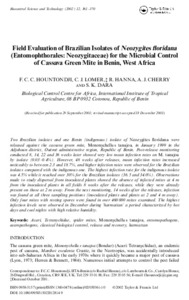| dc.contributor.author | Hountondji, F.C.C. |
| dc.contributor.author | Lomer, C. |
| dc.contributor.author | Hanna, R. |
| dc.contributor.author | Cherry, A. |
| dc.contributor.author | Dara, S.K. |
| dc.date.accessioned | 2019-12-04T11:21:25Z |
| dc.date.available | 2019-12-04T11:21:25Z |
| dc.date.issued | 2002 |
| dc.identifier.citation | Hountondji, F., Lomer, C., Hanna, R., Cherry, A. & Dara, S.K. (2002). Field evaluation of Brazilian isolates of Neozygites floridana (Entomophthorales: Neozygitaceae) for the microbial control of cassava green mite in Benin, West Africa. Biocontrol Science and Technology, 12(3), 361-370. |
| dc.identifier.issn | 0958-3157 |
| dc.identifier.uri | https://hdl.handle.net/20.500.12478/3775 |
| dc.description.abstract | Two Brazilian isolates and one Benin (indigenous) isolate of Neozygites floridana were released against the cassava green mite, Mononychellus tanajoa , in January 1999 in the Adjohoun district, Ouémé administrative region, Republic of Benin. Post-release monitoring conducted 8, 14, 22 and 36 weeks later showed very low mean infection rates on M. tanajoa by isolate (0.03-0.4%). However, 48 weeks after releases, mean infection rates increased noticeably to between 2.3 and 18.7%, and higher infection rates were observed for the Brazilian isolates compared with the indigenous one. The highest infection rate for the indigenous isolate was 4.5% while it reached over 30% for the Brazilian isolates (36.5 and 34.0%). Observations made to study dispersal from inoculated plants showed the absence of infected mites at 4 m from the inoculated plants in all fields 8 weeks after the releases, while they were already present on those at 2 m away. From the next monitoring, 14 weeks after the releases, infection was found at all three sampling positions (inoculated plants and plants at 2 and 4 m away). Only four mites with resting spores were found in over 460 000 mites examined. The highest infection levels were observed in December during 'harmattan' a period characterized by hot days and cool nights with high relative humidity. |
| dc.language.iso | en |
| dc.subject | Acari |
| dc.subject | Tetranychidae |
| dc.subject | Spider |
| dc.subject | Mites |
| dc.subject | Mononychellus Tanajoa |
| dc.subject | Entomopathogens |
| dc.subject | Acaropathogens |
| dc.subject | Classical |
| dc.subject | Biological Control |
| dc.subject | Release |
| dc.subject | Recovery |
| dc.subject | Harmattan |
| dc.title | Field Evaluation of Brazilian isolates of Neozygites foridana (Entomophthorales: Neozygitaceae) for the microbial control of cassava green mite in Benin, West Africa |
| dc.type | Journal Article |
| dc.description.version | Peer Review |
| cg.contributor.affiliation | International Institute of Tropical Agriculture |
| cg.coverage.region | Africa |
| cg.coverage.region | West Africa |
| cg.coverage.country | Benin |
| cg.isijournal | ISI Journal |
| cg.authorship.types | CGIAR single centre |
| cg.iitasubject | Pests Of Plants |
| cg.iitasubject | Plant Diseases |
| cg.iitasubject | Cassava |
| cg.iitasubject | Climate Change |
| cg.accessibilitystatus | Limited Access |
| local.dspaceid | 95930 |
| cg.identifier.doi | https://doi.org/10.1080/09583150220128149 |

